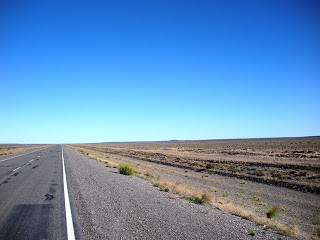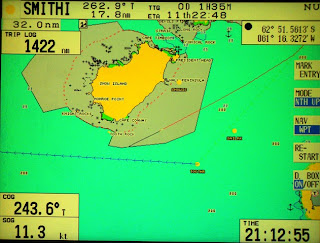
Along the way there was... NOTHING! You will find this to be a recurring theme for the next few days. Miles of pampas, interrupted on occasion by extreme monotony. I did see quite a few guanacos along the way, and finally caught site of several flocks of ñandú. These are an ostrich-like bird that is native to the pampas. Unfortunately, they are very shy and very fast, so by the time I got my camera out they were gone. So I´m cheating (truth in advertising) by putting a picture here that I grabbed from the internet so you´ll know what I saw

I won´t bore you with too many details of the next three days... I had enough boredom for all of us. But basically, stare closely at the picture at the right and then multiply it by 2400 kilometers and you´ll have a good idea of this part of the ride. I plugged in my Ipod (thank you Bill Gates), cranked up the music, set the autopilot (at one point there was a stretch going due north for 100 miles without one single curve), and pushed on.
I stopped the first night in Caleta Olivia, a beach town in the middle of nowhere. The next morning as I was passing through Comodoro Rivadavia I decided to replace my rear tire that was showing a bit too much wear. It only had 3000 miles on it, but the ripio (gravel roads) really tear up the tires.
I found a tire at a Honda shop that would work, but of course they only sell tires... they don´t mount them. That would have been a level of service above and beyond the call of duty. They did however, send me to a tire shop that would mount the tire. However, they wouldn´t take the wheel off of the bike to do it... that would have been a level of service above and beyond the call of duty. So there I spent the morning sitting in the middle of the road removing and reinstalling wheels so that they could change the tire. No proper jack, of course. It didn´t help that I also had a sprained wrist that was bothering me. I have to wonder what someone would do who didn´t know how to do this or have the tools. Ah... customer service at its best.
The only other problem on this stretch was gas. There are enough gas stations along the route, but this being high season many of them run out of gas. This became a problem a couple of times when I had to return to the last city to fill up. My gas milage on this stretch was terrible. While I usually get at least 40 mpg, two things cut this drastically. First, I was going as fast as possible to get this part of the ride over with. I usually cruise at about 100 kph, but I was pushing it to 120-135. The KLR is one of the least aerodynamic bikes ever built, and at higher speeds it is like pushing a brick wall. Then there was the wind. It usually ranged from 40 to 60 miles and hour (sometimes gusting more), and never seemed to come from behind me. So I was either leaning over at 45 degrees, or fighting a direct head wind.
I actually only ran out of gas once: First I ran out and switched to reserve. Then the reserve ran out, but there is a little trick with the KLR that where you lean it WAY over to the left and drain some gas out of the right side of the tank. This worked for another 15 km or so. Then there was the final time. Dead bike. No gas. Nada. Not even fumes. The happy ending: This happened about 100 meters from a gas station! It was the only time on the whole trip that I completely ran out of gas and it is obvious that the gas fairies were looking out for me!
That night I made it to San Antonio del Oeste, and the next day rode the final 900 km to Mar del Plata. My friend Alicia had offered to loan me her apartment there, so I was planning on a few days rest before finishing the trip in Buenos Aires.






















































